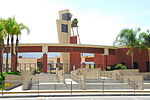Grand Boulevard (Corona)
Beltways in the United StatesCalifornia road stubsHistoric districts on the National Register of Historic Places in CaliforniaNational Register of Historic Places in Riverside County, CaliforniaRoads on the National Register of Historic Places in California ... and 3 more
Streets in Riverside County, CaliforniaTransportation in Corona, CaliforniaUse mdy dates from August 2023

Grand Boulevard is a beltway in Corona, California that was recognized by the National Register of Historic Places in 2011 as a part of the Grand Boulevard Historic District.It is an ordinary surface street that circles the city's historic downtown area and is approximately half a mile from the city center. It is unusual for being perfectly circular. The street was designed by Hiram Clay Kellogg (In memory of him, there is a street in Corona named Kellogg Street). Grand Boulevard was home to international races in 1913, 1914 and 1916. Grand is easily accessible from the Main Street exit on California State Route 91.
Excerpt from the Wikipedia article Grand Boulevard (Corona) (License: CC BY-SA 3.0, Authors, Images).Grand Boulevard (Corona)
East Grand Boulevard, Corona
Geographical coordinates (GPS) Address Nearby Places Show on map
Geographical coordinates (GPS)
| Latitude | Longitude |
|---|---|
| N 33.869166666667 ° | E -117.56722222222 ° |
Address
East Grand Boulevard
East Grand Boulevard
92879 Corona
California, United States
Open on Google Maps





